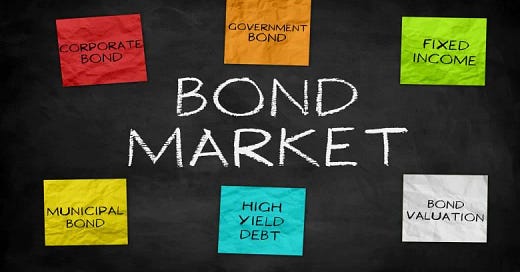Interest rates and bonds are purposely complex in nature but incredibly important to understand if you are going to be good at managing money.
The elites make it very confusing so you don’t have a damn clue what’s going on behind the curtains.
“It is well enough that people of the nation do not understand our banking and monetary system, for if they did, I believe there would be a revolution before tomorrow morning.” - Henry Ford
Bonds are counterintuitive and your brain has a hard time comprehending what’s going on as it is.
Companies and governments are generally the biggest bond issuers. But anyone who issues a note promissory or some type of document to lend money with a promise to pay back, is a form of bond.
Root word for bondage. In debt to someone.
I’ll break down in a couple quick steps (and over next couple posts) the most important aspects to understand about the bond market.
Treasury Bills = 3-12 months maturity (lending period)
Treasury Notes = 2-10 years maturity (lending period)
Treasury Bonds = 15-30 years maturity (lending period)
Bills = Notes = Bonds
They are all a form of bond, by naming them different is just a way to quickly differentiate maturity.
Why are bonds important?
Bonds are how much of the world raises money to fund projects, investments, or businesses.
Warren Buffett has liked bonds cause he has always believed in the ability of the government to tax its citizens to pay the bonds back (our national debt.)
Most retirement, insurance, and endowment investment portfolios for decades have been set up with 40% allocation to bonds and 60% to stocks.
Those have been getting crushed hence why so many people’s retirements are under water.
If you know how bonds work you can start to see “where the puck is going,” as hockey icon Wayne Gretzky stated.
It’s time to change that.
Bonds have been in a 5,000 year bubble high and generating minimal if not negative returns (meaning bond prices are high and interest rates are low.)
How are you supposed to retire on year after year of negative returns?
Bitcoin has been appreciating at 150% to 200% CAGR (cumulative annual growth rate) the last 13 years.
It may be worth investing 1 to 10% of your portfolio into bitcoin to hedge the insanity at minimum.
Stay strong,
Brandon
Ps. The next post tomorrow will be about how exactly interest rates work with bonds and why they are inverse and made so confusing. Incredibly important if you are looking to retire anytime soon and manage your own portfolio or at least know how to talk to your financial advisor.




